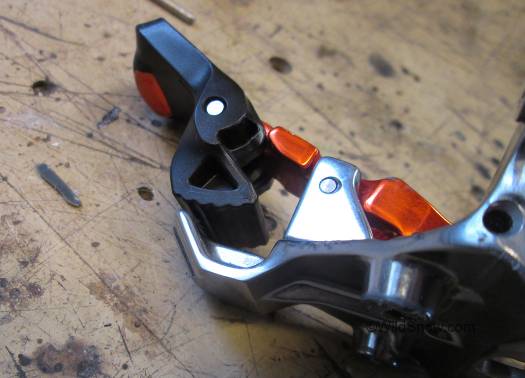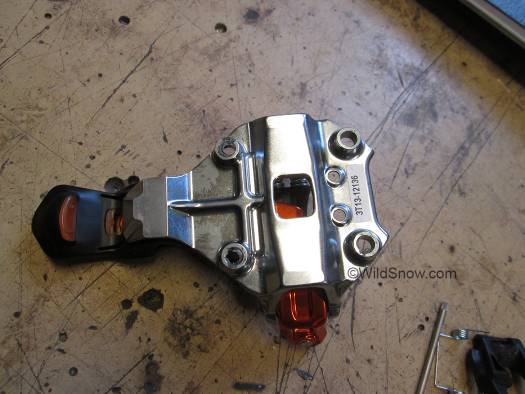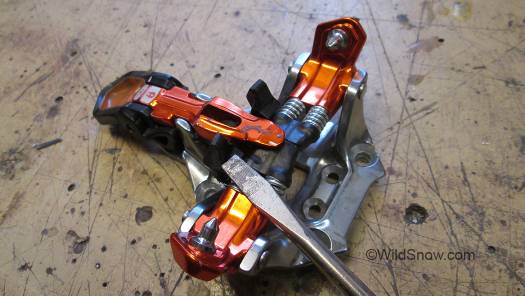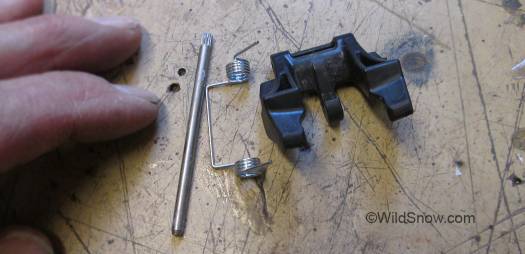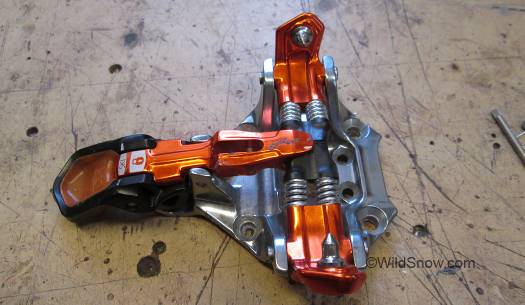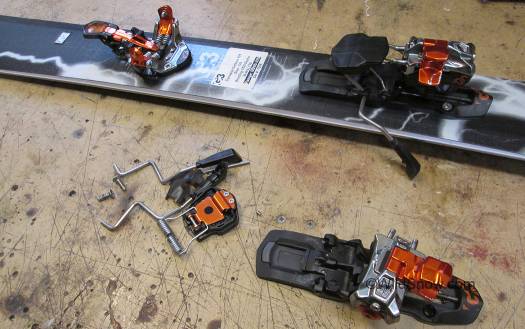
G3 ION complete on ski, and with brake removed. G3’s branding style is to spell ION in all caps. What a hassle writing that. So below I’ll try to hit the capslock key when appropriate; don’t freak if I miss it.
We still heart the looks and on-snow feel of the ION, G3’s new offering on the tech binding altar. Louie’s previous user review is good. To supplement, here’s what jumped out during my own days with the rig.
ION tech binding overall has a “put together” ethos that inspires confidence. From the bi-directional and easily operated heel lifters, to the obviously strong springs in the toe, this horse shouts “ride me!” Everything is beefed. “Freeride” is the claim.
In use, I paid close attention to any tendency for “auto rotation” of the ION heel unit, a syndrome of many other tech binding brands and designs. The freshman grabber appears to have a super solid anti-rotation system. Basically, you can rotate the heel either clockwise or counter-clockwise for touring mode. Yet once you move the heel into touring position it is strongly blocked from rotating farther. The heel lifters are angled in such a way to make your boot heel press down and exert any rotational force towards the blocking direction. This is the same idea as some of the other systems on the market, which tend to work more or less effectively. Thus, ION seems to be on the good side of all the anti-rotation gimmickry.
This is where I’m supposed to mention the ION brake. You retract the brake for touring by first rotating the heel unit to touring position, then pressing down with foot or hand which clicks the brake into a small hook that holds it closed. Going to downhill mode reverses the process. For those of you familiar with G3 Onyx binding, it’s similar.
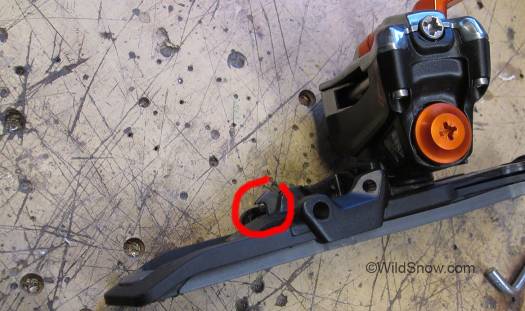
Brake removed, showing hook that catches brake when you’re in touring mode. This is similar to how the G3 Onyx brake functions.
The ION brake concept is good, but somehow my brake would come unclicked while in touring mode, resulting in fairly good traction as I dragged the open brake up the skin track, but not really efficient and a bit hard on the brake arms (I eventually bent them). I tried to simulate this on the workbench with no luck. G3 says they will mitigate this in the production binding but it’s a serious enough problem to be worth mentioning regarding a pre-production unit (I usually hold most of such criticism until we test production/retail stuff). On a positive note, the brake deployment springs are STRONG and overall the brake looks beefy. This is a ski stopper, not a toy. Freeride! Or easily remove the brake. So here we go with How To Remove ION Brake or in other words uninstall it, or delete it.
The most ingenious part of ION is the small indexing tabs that rise up in front of your boot toe when the binding is open, and retract when you step in. Kudos to G3 for addressing the issue of “tech-fiddle,” that situation which occurs at the top of the perfectly carpeted pow slope, as you stand and wait for the newbie in the group to “fiddle” her boot into the binding.
In carpet testing with a variety of brands and model boots the ION boot entry guide did contribute to making ION much easier to “step in.” On the other hand, add some chunks of icy snow, a damaged boot toe, or a non-standard shaped boot toe, and this feature becomes vestigial. In the field I found the step-in guides to be of limited use to me as an experienced tech binding “stepper inner.” Sometimes the guides actually made binding entry more difficult when snow or ice was packed around the vicinity of my boot toe. My take would be to try the binding with this feature, then remove if you don’t like. The stepper-inner-thingus is super easy to extricate; just drive one pin out of the toe unit. Takes about two minutes per toe.
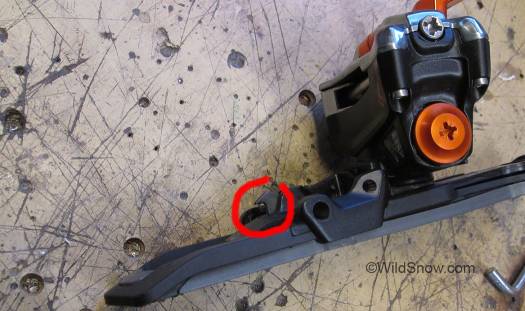
Note the pozi screw adjustment for everything. This feature is hyper plus for backcountry skiers; how important it is for freeride is an open question. Freeride backpacks I saw in St. Anton don’t have room for even a single screw driver.
Ever think your repair kit is too heavy? Or you can’t fit it in your tiny Gucci freeride rucksack? If you go with ION throw out a few driver bits. Just keep your pozi drive stuff; every screw and threaded part on ION works with a #3 Pozi. Isn’t it weird that other brands don’t do this? So elegant. G3 should win a prize for that feature alone.
Bench Racing
One production Dynafit 2013/14 ST Radical (sitting here on my workbench in a bag) with 100 mm brake and screws weighs 20.5 ounces or 584 grams with screws; move up to the FT and discard the connector plate, weight is virtually the same. The Radical binding gets a revamp for 2014/15 with production weight an unknown at this time. I suspect it’ll be similar, though we won’t be surprised if it gains a few grams.
Our pre-production NON-demo-version ION binding weighs the following with NO screws: ION toe: 6.1 ounces, 172 grams, ION heel with 105mm brake: 14.8 ounces, 420 grams, Total pre-production non-demo ION 20.9 ounces, 592 grams. (I’ll add the screw weights back in eventually, away from workshop at this time.)
Some of you will opine that’s a trivial weight difference from the “other brand,” especially when you consider the Dynafit ST Radical, which ends up being virtually the same weight (as mentioned above). Thus, you’ll purchase by reputation and perhaps nation or brand loyalty. Those of you who are weight fixated should consider the below.
1. The boot toe indexing “stepper inner” unit on the ION is a good idea, but doesn’t always help and is unnecessary if you’re used to tech bindings. More, with ice or packed snow it can actually get in the way of clipping in. The parts remove easily, saving .3 ounce 8 grams per binding. This is not exactly an award winner in the gram trimming mod contest, but as any weight weenie knows, it all adds up…
2. ION is easily de-braked (Dynafit Radical FT and ST are not). Punch out a pin, pry a few things off with a screwdriver, wriggle out the brake arms, and you’ve hacked off 3.4 ounces, 100 grams.
3. Thus, if you remove both the toe indexer and the brake, you end up the non-demo retail ION binding weighing about (need to verify retail version) 17.5 ounces. That’s pretty good for a beefy tech binding, with heel-spring-shock feature and overall “freeride” strength. For ski touring (not freeride) a good cross-brand comparo with no brake is the Dynafit Speed Radical, it has no brake and weighs 13.2 ounces 374 grams (with screws and crampon fitting).
(Modders, note that ION still has anti-rotation with brake removed as far as seems appropriate. Dynafit FT/ST with brake parts completely removed has no anti-rotation feature. I’ll not get into it any more than that, as the mysteries of modding should sometimes be allowed to persist.)
Disregarding issue with brakes, what’s the biggest difference between ION and Speed Radical besides weight (since you asked)?, ION has super positive anti-rotation lock, while the Dynafit Speed resists heel rotation with an elegant but less forceful system that’s more sensitive to boot angle and snow packing. In terms of anti-rotation, I’d say the Dynafit Radical ST/FT comes in somewhere between the Speed Radical and ION in terms of resisting rotation.
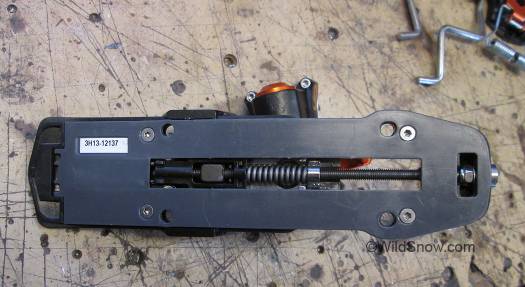
Underside shows the spring loading machinery. For most ski tourers this is a solution without a problem (original tech binding system has intelligent pins that slide in and out of the boot heel, elegant), but in the case of aggressive freeride it probably helps when your ski flexes and your boot heel encounters the heel unit (something has to give.)
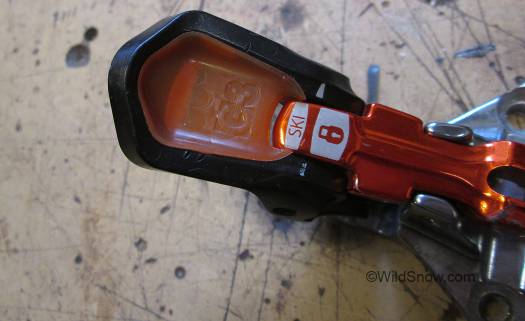
Bonus shot. We like the urethane pole tip pocket in the toe lock lever, durable and easy to target. Ever seen other brands shatter here? Perhaps not these guys.
P.S.A., G3 asked me to emphasize that when adjusting ION for boot length, the heel should be brought in to where it just barely kisses the boot heel. Probably to the point where you can still pull a piece of paper out without tearing it. In other words, at rest the binding has NO FORWARD PRESSURE. Truly, using the term “forward pressure” in this situation is a misnomer. It’s simply “adjustment for boot length.” Some skiers steeped in the ancient arcanity of forward pressure may think that if the binding is adjusted close to the boot heel, a few extra turns of the screwdriver will somehow make it work better. Don’t be tempted. Cranking the binding heel too far forward will result in binding damage or pre-release, void your warranty, and possibly cause you grievous harm.
Check out our Ion screw hole pattern rendition and mount template.
ION will be available this coming fall of 2014. We tend to recommend this binding as an option, but as always we encourage waiting until first consumer retail testing phase is completed by courageous early ski binding adopters.
(Note, for shops or modders: Our latest ION evaluation binding weight (demo/rental model with extended boot adjustment range) scales out thus: Complete binding with 110 mm brake and screws is 23.2 ounces 656 grams.)
WildSnow.com publisher emeritus and founder Lou (Louis Dawson) has a 50+ years career in climbing, backcountry skiing and ski mountaineering. He was the first person in history to ski down all 54 Colorado 14,000-foot peaks, has authored numerous books about about backcountry skiing, and has skied from the summit of Denali in Alaska, North America’s highest mountain.

